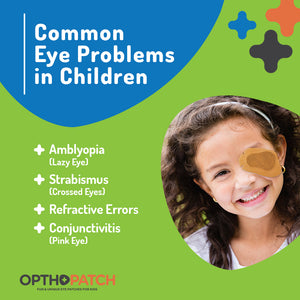Common Eye Problems in Children
October 30, 2020

From birth until the age of 4, a child's vision is continuously developing and can be vulnerable to eye disease. These years are crucial for developing healthy vision and the skills needed for learning and interacting with others.
So what are the most common eye problems in children? How can you recognize the symptoms of eye disorders in your toddler? This guide will help you understand how to keep your child’s visual development on track.
5 Common Eye Problems in Children
Toddlers can face many problems when it comes to their vision. Some of the most common eye problems in toddlers and their causes include:
-
Conjunctivitis (Pink Eye) is extremely common in children. There are three different types of conjunctivitis, which have varying causes:
- Bacterial conjunctivitis is caused by bacteria, and can cause serious damage to an eye if it is not treated.
- Viral conjunctivitis is caused by viruses, such as the common cold.
- Allergic conjunctivitis is caused by irritants such as pet dander, mold and pollen. It can flare up during the seasons that your toddler experiences allergies.
- A child’s eyes may be red, itchy, teary or have a sticky discharge. Keep your child home from school if they have contagious pink eye. Pink eye usually goes away on its own in a week. You can usually control symptoms at home, but sometimes a doctor prescribes antibiotic eye drops.
-
Amblyopia is poor vision in an eye that did not develop vision normally in childhood. It’s also called “lazy eye.” A child can get Amblyopia when they do not get treated for problems like refractive errors, Strabismus (misaligned eyes), droopy eyelids or cataracts.
-
Refractive errors, such as astigmatism, hyperopia (farsightedness) and myopia (nearsightedness) are very common among toddlers and children. If a child does not see correctly for long enough, they can lose vision and get a “lazy eye.” Correct your child’s refractive error with the right prescription glasses.
-
Strabismus (misaligned or crossed eyes) happens in about 4 percent (4 out of 100) children. One eye may look straight ahead while the other turns in, out, up or down. Strabismus needs to be treated as soon as possible.
Spotting Eye Problems in Toddlers
Vision problems like the ones listed above are common in toddlers, but they won’t likely be able to identify the problem by themselves — especially if they have not begun talking yet. Because of this communication barrier, it is important for you, as a parent, to be able to identify signs and symptoms of eye problems in your toddler.
Signs that a child may have vision problems include:
- constant eye rubbing
- extreme light sensitivity
- poor focusing
- poor visual tracking (following an object)
- abnormal alignment or movement of the eyes (after 6 months of age)
- chronic redness of the eyes
- chronic tearing of the eyes
- a white pupil instead of black
In school-age children, other signs to watch for include:
- being unable to see objects at a distance
- having trouble reading the blackboard
- squinting
- difficulty reading
- sitting too close to the TV
These symptoms may seem insignificant at first, but they could indicate bigger problems. Maintaining your toddler’s visual health involves taking safety precautions, recognizing the symptoms of eye problems and knowing when to consult an eye doctor for potential treatment. Untreated infection, refractive error and misaligned eyes can harm vision. By finding and treating problems early, healthy vision can develop.
If you are concerned that your child might be experiencing any of these symptoms, we highly encourage you to schedule an appointment with your eye doctor for a thorough eye examination. And make it sooner than later.
